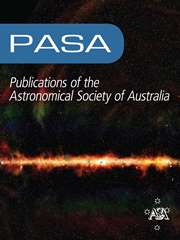No CrossRef data available.
Article contents
Percent-level timing of reionization: self-consistent, implicit-likelihood inference from XQR-30+ Lyα forest data
Published online by Cambridge University Press: 14 April 2025
Abstract
The Lyman alpha (Lyα) forest in the spectra of z > 5 quasars provides a powerful probe of the late stages of the Epoch of Reionization (EoR).With the recent advent of exquisite datasets such as XQR-30, many models have struggled to reproduce the observed large-scale fluctuations in the Lyα opacity. Here we introduce a Bayesian analysis framework that forward-models large-scale lightcones of intergalactic medium (IGM) properties, and accounts for unresolved sub-structure in the Lyα opacity by calibrating to higher-resolution hydrodynamic simulations. Our models directly connect physically-intuitive galaxy properties with the corresponding IGM evolution, without having to tune “effective” parameters or calibrate out the mean transmission. The forest data, in combination with UV luminosity functions and the CMB optical depth, are able to constrain global IGM properties at percent level precision in our fiducial model. Unlike many other works, we recover the forest observations without invoking a rapid drop in the ionizing emissivity from z ∼ 7 to 5.5, which we attribute to our sub-grid model for recombinations. In this fiducial model, reionization ends at z = 5.44 ± 0.02 and the EoR mid-point is at z = 7.7 ± 0.1. The ionizing escape fraction increases towards faint galaxies, showing a mild redshift evolution at fixed UV magnitude, MUV. Half of the ionizing photons are provided by galaxies fainter than MUV ∼ –12, well below direct detection limits of optical/NIR instruments including JWST. We also show results from an alternative galaxy model that does not allow for a redshift evolution in the ionizing escape fraction. Despite being decisively disfavored by the Bayesian evidence, the posterior of this model is in qualitative agreement with that from our fiducial model. We caution however that our conclusions regarding the early stages of the EoR and which sources reionized the Universe are more model-dependent.
Keywords
- Type
- Research Article
- Information
- Creative Commons
- This is an Open Access article, distributed under the terms of the Creative Commons Attribution licence (https://creativecommons.org/licenses/by/4.0/), which permits unrestricted re-use, distribution and reproduction, provided the original article is properly cited.
- Copyright
- © The Author(s), 2025. Published by Cambridge University Press on behalf of Astronomical Society of Australia


